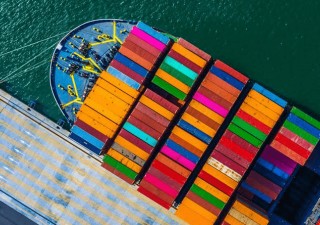“The reality is that China possesses a number of attributes that are hard to find elsewhere: scale; abundant skilled and unskilled labor; growing sophistication in automation; the ability to produce goods across an array of industries and the full spectrum of value; integration with other Asian producers; advanced logistics and transportation infrastructure.”
Vietnam, Malaysia, Indonesia, Mexico
The Agility GIL executive said of the small number of companies that moved production from China prior to the Covid crisis, “most did so because of US-China trade friction or rising labour costs in China.”
“Vietnam, Malaysia, Indonesia and Mexico were the most common locations chosen by companies that moved production,” Blaufuss added, noting that India is also getting fresh scrutiny as a possible manufacturing base.
Kuehne+Nagel said separately that the coronavirus pandemic will not lead to “substantial, long-term changes” in terms of supply chains in Asia as companies have long started moving out of China mainly due to increasing labour costs.
“The trend for regionalization in supply chains in Asia is something we have seen for more than a decade. Take the example of Vietnam, which has managed to position itself in terms of manufacturing very consequently,” the Switzerland-headquartered logistics firm said in a statement.
“We have seen businesses shifting part of their production and assembly operations outside of China for some time now. Manufacturers are relocating their operations to Southeast Asian countries like Vietnam, Thailand and Indonesia.”
China to continue to play major role
Kuehne+Nagel noted that moving production from country to country is “not a simple process” for companies due to the world-class infrastructure that China has built over the years and is complemented by a large market base, skilled workers, advanced technologies, distribution systems and a network of suppliers.
“Decoupling is about finding alternatives for future growth and complementing the advantages of the Chinese market. We believe that China will continue to play a very important role in the supply chain also in the future,” Kuehne+Nagel added, noting that “for supply chain regionalization to take place, it will depend on the determination of companies to commit to such a large move.”
“It very much depends on industries and their impact of disruption from the accelerating trends. The Covid-19 crisis may have accelerated the case for businesses to undergo a critical rethinking of their supply chain strategy,” it further said.
Kuehne+Nagel noted that, moving forward, having real-time visibility and accurate data is “especially critical” to building a resilient supply chain.
Evolving supply chains
Meanwhile, DHL Supply Chain (Asia Pacific) CEO Terry Ryan also noted that even before the pandemic, the global logistics company has already seen customers “reorganize their supply chains beyond China to other Asian markets” – which he said could be due to cost, access to markets, raw materials, labour, and companies looking to diversify their investments and, correspondingly, their supply chain operations.
“Rather than disperse manufacturing across the globe, regionalization allows companies to benefit from mobilizing products swiftly given they are closer to their customers and end consumers, and also helps remove barriers associated with efficiency, transportation and delivery,” Ryan told Asia Cargo News, adding that these benefits have encouraged many companies to shift to a global sourcing model, to capitalize on lower costs for labor and materials, land, and other factors.
However, he explained that this is not to mean that ‘globalization’ as a concept is no longer relevant since global trade and movement of goods, “be it continental, regional or global, would still be a necessity to ensure economies continue on their growth trajectory.”
Focus on Southeast Asia
“While it is still too early for us to fully grasp the full impact of Covid-19 on the global economy, the pandemic has highlighted the interdependencies of supply chains worldwide. We hold the view that while we will continue to see more regionalization of supply chains in the near future, global supply chains will continue to evolve and uphold its importance,” Ryan said.
“We have seen the shift even before the pandemic and we expect this to continue, as various sectors (especially those who are hardest hit, for example electronics and auto-industries) adapt to adjust their supply chain networks.”
In particular, Ryan noted that DHL is seeing the emergence of some Asian markets such as Thailand and Vietnam as plausible production and distribution main points for automotive and electronics sectors. Taiwan has always been a strong spot for high-tech manufacturing and its physical proximity to China makes it an ideal alternative.
He said India is also another significant hotspot, as its fragmented logistics industry starts to consolidate and live up to its potential. DHL is also seeing significant new activity in Indonesia, boosted by the growth and maturity of the country, matched with the availability of a strong educated large workforce with excellent connectivity to all global markets.
“While we foresee that there could be reallocation in some parts of the manufacturing sector, in part because regionalization does in a way help propel supply chain management to be more efficient, we also expect to see increased outsourcing of contract logistics, currently already one of the growth factors for the supply chain globally,” Ryan said.
“Overall, we do not think that supply chains will drastically change post-Covid, as business models have been evolving for some time now. Having said that, changes along the global supply chains are not threats to our business. They are part of our business,” he added.
Digitization of supply chains
Looking ahead, Ryan said DHL expects to be “very focused” on enabling digitalization to adopt new technologies that will allow the company to optimize work processes and to maximize efficiency.
As part of DHL Group’s Strategy 2025, the focus on accelerating digitalization in its operation include automation, and investment into 1,000 new robots to improve DHL’s productivity throughout the supply chain.
Ryan said DHL is also “looking to invest in markets where we are seeing high growth potential, especially in Asia.”
Charlee C. Delavin








